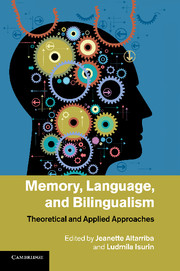Book contents
- Memory, Language, and Bilingualism
- Memory, Language, and Bilingualism
- Copyright page
- Contents
- Figures
- Tables
- Contributors
- Introduction
- 1 Bilingual memory:
- 2 Lexical competition in localist and distributed connectionist models of L2 acquisition
- 3 Working memory and (second) language processing
- 4 Working memory in simultaneous interpreters
- 5 Using electrophysiological measures to track the mapping of words to concepts in the bilingual brain:
- 6 Age effects in L2 learning:
- 7 Bilingualism, language, and aging
- 8 Crossovers and codeswitching in the investigation of immigrant autobiographical memory
- 9 Linguistic relativity and bilingualism
- 10 Testing effects for novel word learning in Chinese–English bilinguals
- 11 The lexicon in second language attrition:
- 12 Memory and first language forgetting
- 13 Future research directions:
- Index
8 - Crossovers and codeswitching in the investigation of immigrant autobiographical memory
Published online by Cambridge University Press: 05 November 2012
- Memory, Language, and Bilingualism
- Memory, Language, and Bilingualism
- Copyright page
- Contents
- Figures
- Tables
- Contributors
- Introduction
- 1 Bilingual memory:
- 2 Lexical competition in localist and distributed connectionist models of L2 acquisition
- 3 Working memory and (second) language processing
- 4 Working memory in simultaneous interpreters
- 5 Using electrophysiological measures to track the mapping of words to concepts in the bilingual brain:
- 6 Age effects in L2 learning:
- 7 Bilingualism, language, and aging
- 8 Crossovers and codeswitching in the investigation of immigrant autobiographical memory
- 9 Linguistic relativity and bilingualism
- 10 Testing effects for novel word learning in Chinese–English bilinguals
- 11 The lexicon in second language attrition:
- 12 Memory and first language forgetting
- 13 Future research directions:
- Index
Summary
Using a cue-word paradigm from autobiographical memory, we report on an investigation of bilingual memory and codeswitching among immigrant adults. The aims of the chapter are threefold: (1) to analyze the relationship between language and memory among bilingual immigrants via same language and crossover memories (memories which were cued in one language yet retrieved in the other language the bilingual knows); (2) to examine the extent to which immigration influences classical memory patterns; and (3) to find out whether behavioral evidence – codeswitching – exists to support immigrants’ self-reported memory retrieval of crossover memories. Twelve English–Hebrew bilingual immigrants aged 64–79 were asked to retrieve specific memories to cue words in separate first language (L1) and second language (L2) sessions. Following retrieval of memories, participants were asked to report the decade of the memory event and the language in which the memory came to them. Results replicated Schrauf and Rubin (1998, 2000), showing evidence for a reminiscence bump (a higher than expected number of memories during the 10–30 age period) and a trend toward an immigration bump in bilinguals who immigrated at a later age. Overall, 40 percent of the memories recalled were “crossovers” (i.e., memories in a language that differed from the language of the experimental session and cue word). In an attempt to find behavioral correlates for “crossover” judgments, narratives from selected memories were examined for the extent of within-utterance bilingual codeswitching. Narratives elicited for selected memories revealed more codeswitching in crossover memories, showing evidence for a consistency between reported memories and bilingual language behavior.
- Type
- Chapter
- Information
- Memory, Language, and BilingualismTheoretical and Applied Approaches, pp. 211 - 235Publisher: Cambridge University PressPrint publication year: 2012
- 2
- Cited by



